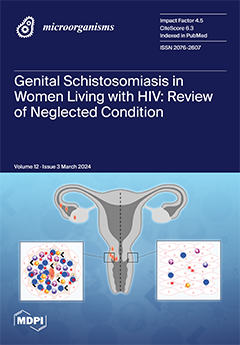A highly active alkaline phosphatase (ALP) of the protein structural family PhoA, from a mussel gut-associated strain of the marine bacterium
Cobetia amphilecti KMM 296 (CmAP), was found to effectively dephosphorylate lipopolysaccharides (LPS). Therefore, the aim of this work was to perform a
[...] Read more.
A highly active alkaline phosphatase (ALP) of the protein structural family PhoA, from a mussel gut-associated strain of the marine bacterium
Cobetia amphilecti KMM 296 (CmAP), was found to effectively dephosphorylate lipopolysaccharides (LPS). Therefore, the aim of this work was to perform a comprehensive bioinformatics analysis of the structure, and to suggest the physiological role of this enzyme in marine bacteria of the genus
Cobetia. A scrutiny of the CmAP-like sequences in 36 available
Cobetia genomes revealed nine homologues intrinsic to the subspecies
C. amphilecti, whereas PhoA of a distant relative
Cobetia crustatorum JO1
T carried an inactive mutation. However, phylogenetic analysis of all available
Cobetia ALP sequences showed that each strain of the genus
Cobetia possesses several ALP variants, mostly the genes encoding for PhoD and PhoX families. The
C. amphilecti strains have a complete set of four ALP families’ genes, namely: PhoA, PafA, PhoX, and two PhoD structures. The
Cobetia marina species is distinguished by the presence of only three PhoX and PhoD genes. The
Cobetia PhoA proteins are clustered together with the human and squid LPS-detoxifying enzymes. In addition, the predicted PhoA biosynthesis gene cluster suggests its involvement in the control of cellular redox balance, homeostasis, and cell cycle. Apparently, the variety of ALPs in
Cobetia spp. indicates significant adaptability to phosphorus-replete and depleted environments and a notable organophosphate destructor in eco-niches from which they once emerged, including
Zostera spp. The ALP clusterization and degree of similarity of the genus-specific biosynthetic genes encoding for ectoine and polyketide cluster T1PKS, responsible for sulfated extracellular polysaccharide synthesis, coincide with a new whole genome-based taxonomic classification of the genus
Cobetia. The
Cobetia strains and their ALPs are suggested to be adaptable for use in agriculture, biotechnology and biomedicine.
Full article






